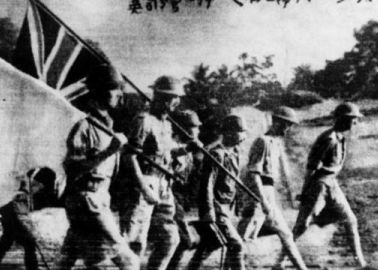The Fall of Singapore

Singapore was an important British military base which was completed just before the outbreak of World War II. The British military suspected that the island was highly likely to be attacked by the Japanese after the attack on Pearl Harbor, however, the military commanders made three crucial mistakes. Firstly, they thought that Singapore was an impregnable fortress, secondly, they underestimated the Japanese military force by thinking that they are not a match to the British military force and lastly, they thought that the sea is only way to invade the island. As a result, they virtually did not do anything to prepare for an eventual Japanese attack. There was even a story that the newly completed military base will deter the Japanese from attacking the island.
Almost simultaneously with the attack on Pearl Harbor, the Japanese forces invaded Malaya from Indochina. Although they were outnumbered, the Japanese overwhelmed the Allied forces and shocked the British Commonwealth military staff with their speed and discipline. The perception that the Japanese are no match to the British Army was soon shattered. By the end of January 31, the Allied forces were forced to withdraw from Malaya to Singapore, while the RAF bases in Singapore that were destroyed by the Japanese during the invasion of Malaya could not provide aerial support to the infantry. After the RAF was put out of action, the Japanese aerial force focused on the only two battleships in the area - Prince of Wales and Repulse and sunk both ships on December 10.
Despite the fact that the Japanese invasion of Malaya demonstrated that they should not be underestimated, Lieutenant General Arthur Percival who commanded the British Commonwealth Army which consisted from the British 18th Division and Australian, Indian and Malayan troops still underestimated the Japanese strength and failed to realize that the Japanese are not fighting by the "book". He was certain that the Japanese troops will not attack across the Johor Strait but from the sea and as a result, he spread his forces along the 70 mile long coastline. On February 8, the Japanese, however, attacked exactly where they should not. Percival's forces were spread too thinly to be able to repulse the invading Japanese, while most troops were too far away to be able to provide assistance.
Although Percival had on disposal 90,000 men, they could not prevent the Fall of Singapore to the Japanese who invaded with the force of less than 30,000 men. They were, however, well trained and experienced, while many of the Percival's forces have not seen a combat by the time. On February 15, 1942, the British Commonwealth forces surrendered and Singapore fell into the Japanese hands.
The Fall of Singapore was humiliating for the British. It was one of the most devastating Commonwealth's defeats and the largest capitulation in British history which severely diminished the British military prestige in the Far East. More than 130,000 men were taken prisoners, while many died in captivity due to mistreatment. The Japanese occupation of Singapore, however, was also marked by brutality towards the civilian population, especially the Chinese. Commander of the Japanese forces that invaded Singapore, General Tomoyuki Yamashita was tried for war crimes after the end of the war and sentenced to death by hanging, however, he was not tried for crimes in Singapore.
Percival's Role in the Fall Singapore
The commander of the British Commonwealth during the Fall of Singapore, Arthur Percival was long held responsible for the defeat for poorly prepared defense. Despite the fact that the Japanese were not fighting the conventional war and that there were clues that the main attack will not come from the sea, Percival decided to defend the entire Singapore's coast. His forces outnumbered the Japanese, however, he did not have enough forces to defend the coast and much less the invasion from the across the Johor Strait. When the Japanese attacked, his forces were too thinly spread out and could not move fast enough to repulse the Japanese attack. Even more, Percival refused to send reinforcements to the Australian 22nd Brigade which took the main attack because he was convinced that the main attack will come from the sea.Although Percival's decisions contributed to what Churchill described as "the worst disaster and the largest capitulation in British history", the later analyses of the course of the battle have shown that Percival's decisions alone are not to blame for the defeat. Furthermore, some historians suggest that the Fall of Singapore was inevitable in the given circumstances and that a better conceived defense would probably only prolong the fighting but it would not prevent the fall of the "Gibraltar of the Far East".
Most modern historians are convinced that several factors played a role in the defeat of the British Commonwealth in Singapore including other officers under Percival's command, while many consider the decisions in London just as responsible as Percival's. The British government did not provide the required reinforcements and refused to give permission for invasion of neutral Thailand as suggested by Commander-in-Chief of the British Far East Command, Air Chief Sir Robert Brooke-Popham despite the fact that it became clear that the Japanese will try to capture Singapore.
After the surrender of Singapore, Arthur Percival was held as prisoner of war in the Changi Prison in Singapore until August 1942 when he was first taken to Formosa and them to Manchuria. He spent the war in the Japanese captivity and was freed only at the end of the war by the American forces. He was taken along to the signing of the Japanese surrender on September 2, 1945, as well as to Philippines where he witnessed the surrender of General Yamashita. Singapore formally surrendered to the British on September 12, 1945, however, the Japanese forces continued to govern the island until the arrival of the British troops.




